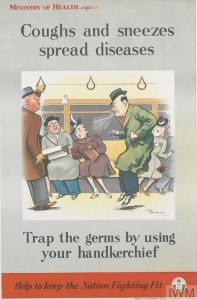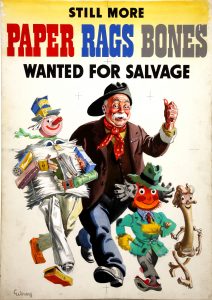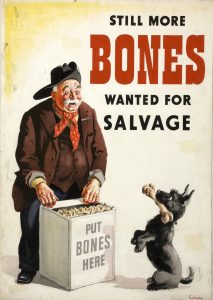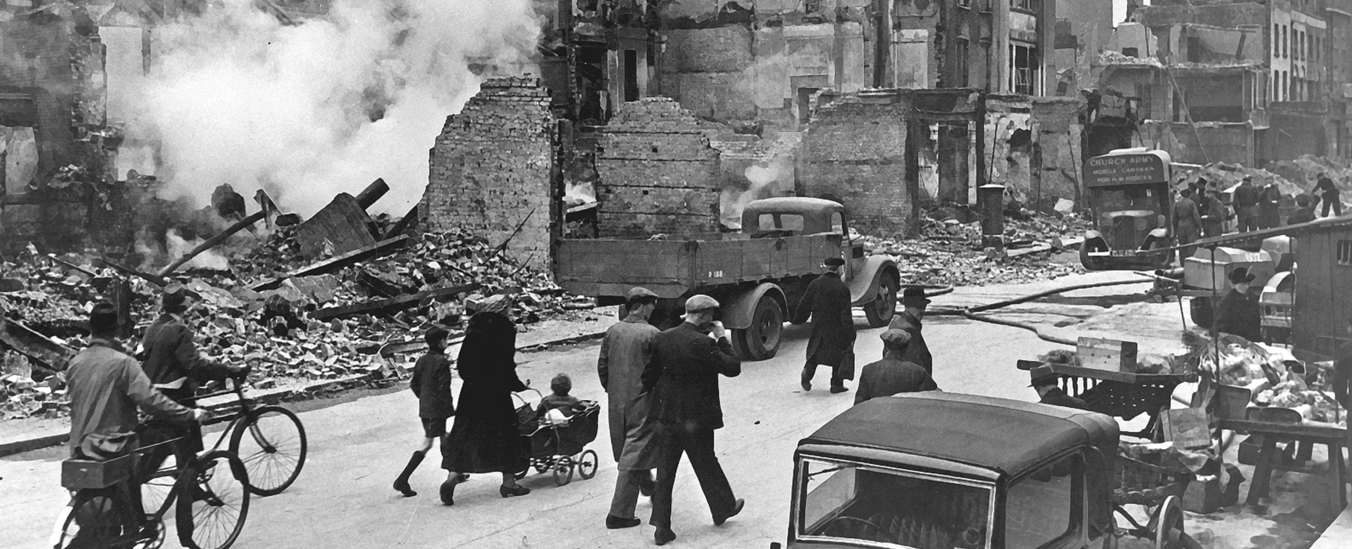
Posters are designed for communicating frequently during the First World War and Second World War. Posters were put everywhere such as schools, stations, hospitals, supermarket and etc. ( iwm.org.uK ) However, one of the major posters with a deep meaning behind it is the “Bones are still needed to make GLUE for housing and FERTILISER for food also other purposes including SOAP…” by the artist Dorrit Dekk. This poster was published between 1939 and 1945. This particular poster can be depicted in several different directions. This poster has a young girl who is running with a bone that is larger than her. Behind the young girl there is a sack with crops shown on it and a bucket with a house shown on it. The color scheme for this poster is interesting. The crops and house are shown in black and grey with a yellow background. The girl and the words “are still needed” are in blue. Looking at the poster and seeing the similar color between the young girl and the words “are still needed” automatically tells audience that women are still needed during the war. The word “bones” in the poster is a metaphor for effort. It is connected to the young girl to put in effort even if she is not fighting in the war. Due to the size of the bone, audience can assume that woman had loads of responsibilities. Also, women are considered the glue for housing and fertilizer for food. They are also handy in other purposes.
The publisher and sponsor for this poster is the Board of Trade and Her Majesty’s Stationary Office. The artist of this poster is Dorrit Dekk and the printed by Gibbs and Waller Ltd. Dorrit Dekk also known as the “travel queen” is a graphic designer whose career started between the first world war and the second world war. (theguardian.com/artanddesign) She is well known for her posters such as “Coughs and sneezes spread diseases” and “Bones are still needed to make glue…”. Both of these posters have a different message but raise awareness. Dekk designed many posters that show subliminal messages regarding the war and the people affected by it.

The Art and Popular Design Department published this poster. In the 20th century the art and popular design published varies art works that represent a unique message. These unique messages were all related on the depiction of the first and second world wars. The artists were also employed during this time for having their posters and messages across. The purpose for popular design to spread their posters is too aim the major issue that were going on at the time. The posters were majority related to the daily experience everyone faced. (iwm.org.uk/collections/art-design) The purpose of spreading these posters everywhere was to raise awareness and persuade people to lend a hand in the war effort. Since men were drafted to the war, women particularly were left behind to handle all house work and fertilize crops for the environment.
This poster is targeting all sorts of audience. From working to middle class women, to men and children who are not involved physically fighting in the war. However, since the poster has a young girl carrying a bone that’s larger than her, the poster is targeted to all females. This poster can also be intended to young children or young adolescence as well.
There are specific needs for this poster. This poster is to push women to do their part in the war and help the environment as well as their homes and others homes. It is also too raise awareness to have people help and be more involved. Posters like this is to encourage woman that they can lend a hand in retrieving their fertilized crops and help build homes without men. Women had to step up on what they can do and Posters like this were made to push females to take part in winning the war.
Posters are very effective during the war for several reasons. Today we have all sorts of outlets like social media and television that spread breaking news in a span on seconds. During World War II, posters, newspapers, radios or announcements were made to have the issue publicized. Posters were very important during the war time because it was a visual approach to encourage people. In other words, every poster had their own specific meaning behind it with a purpose. That purpose is to encourage others to be a part of the war, even if they are not physically apart of it. However, this specific poster is effective. This poster is to raise an awareness of using women power for future goods and purposes.


This poster does not have a larger series; however, they are other posters with similar meaning. This poster has an older man and a dog. This is similar to Dekk’s poster because some older men were left behind. “Still more bones wanted for salvage” is also as if the artist is pushing all genders, all age and all forms of life to complete one task. Anyone can help, even if it’s the smallest effort.







Melissa Dinsman
From your research, what did you find out about saving bones during wartime? Why were fertilizer and glue needed? Was this only for the home front, or were they needed for the front lines as well?
Claudia Etienne
I like the way you analyzed the picture – especially the connections you made to the load that women had to carry and the government’s reliance on women.